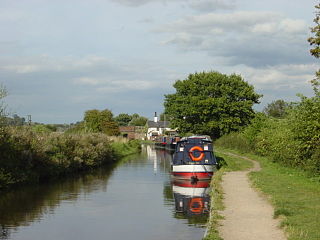
The Trent and Mersey Canal is a 93+1⁄2-mile (150 km) canal in Derbyshire, Staffordshire and Cheshire in north-central England. It is a "narrow canal" for the vast majority of its length, but at the extremities to the east of Burton upon Trent and north of Middlewich, it is a wide canal.
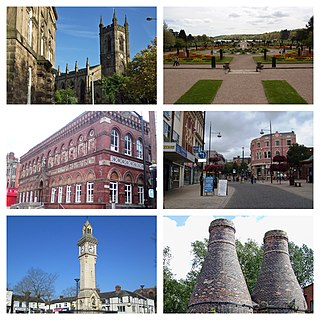
Stoke-on-Trent is a city and unitary authority area in Staffordshire, England, with an area of 36 square miles (93 km2). In 2021, the city had an estimated population of 258,400. It is the largest settlement in Staffordshire and is surrounded by the towns of Newcastle-under-Lyme, Alsager, Kidsgrove and Biddulph, which form a conurbation around the city.

The North Staffordshire Railway (NSR) was a British railway company formed in 1845 to promote a number of lines in the Staffordshire Potteries and surrounding areas in Staffordshire, Cheshire, Derbyshire and Shropshire.

Hanley is one of the six towns that, along with Burslem, Longton, Fenton, Tunstall and Stoke-upon-Trent, amalgamated to form the City of Stoke-on-Trent in Staffordshire, England.

Burslem is one of the six towns that along with Hanley, Tunstall, Fenton, Longton and Stoke-upon-Trent form part of the city of Stoke-on-Trent in Staffordshire, England. It is often referred to as the "mother town" of Stoke on Trent.
Etruria is a suburb of Stoke-on-Trent, Staffordshire, England.

Kidsgrove railway station serves the town of Kidsgrove in Staffordshire, England. The station is 7.5 miles (12.07 km) north of Stoke-on-Trent. The station is served by trains on the Crewe to Derby Line which is also a community rail line known as the North Staffordshire line. The station is owned by Network Rail and managed by East Midlands Railway.

Stoke-on-Trent railway station is a mainline railway station serving the city of Stoke-on-Trent, on the Stafford to Manchester branch of the West Coast Main Line. It also provides an interchange between local services running through Cheshire, Staffordshire and Derbyshire.
The Stafford and Uttoxeter Railway was authorised by Act of Parliament on 29 July 1862, to build a line between the towns of Stafford and Uttoxeter in Staffordshire, England. It opened for traffic in 1867. It opened on 23 December 1867. Construction cost had much exceeded estimates, and income was poor, so that the company was always in financial difficulty. It was placed in receivership in 1875. The Great Northern Railway (GNR) had running powers to Uttoxeter and was persuaded to acquire the company, which it did in 1881. The GNR spent a considerable sum on improving the line, but it never made money and it was closed to passengers on 4 December 1939. Goods traffic ceased in 1951, except for a short stub to RAF Stafford; this too closed in 1975.

Longport railway station serves the areas of Longport, Middleport, Tunstall and Burslem, all districts in the northern part of Stoke-on-Trent, England. The station is served by trains on the Crewe–Derby line, which is also a community rail line known as the North Staffordshire line. The station also has two trains a day on the Stoke-on-Trent to Manchester Piccadilly line. The station is owned by Network Rail and managed by East Midlands Railway.
The Derbyshire and Staffordshire extension of the Great Northern Railway was an English railway network built by the GNR to get access to coal resources in the area to the north and west of Nottingham. The Midland Railway had obstructed the GNR in its attempts to secure a share of the lucrative business of transporting coal from the area, and in frustration the GNR built the line. The line was forked: it reached Pinxton in 1875 and a junction with the North Staffordshire Railway at Egginton, approaching Burton on Trent in 1878. The line cut through Derby, resulting in considerable demolition of housing there.

The Crewe–Derby line is a railway line in central England, running from Crewe in a south-easterly direction to Derby, via Stoke-on-Trent and Uttoxeter. Passenger services on the line are provided by East Midlands Railway.
Basford is a suburb which sits on high ground between Newcastle-under-Lyme and Stoke-on-Trent in Staffordshire, England.
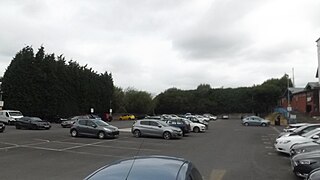
Hanley railway station is a former railway station which was built by the North Staffordshire Railway as part of the Potteries Loop Line and served the town of Hanley, Staffordshire, England.

Burslem railway station was a station on the Potteries Loop Line that served the town of Burslem, Staffordshire. It was located on Moorland Road, adjacent to Burslem Park. It should have opened with the extension of the Potteries Loop Line from Hanley on 1 November 1873 but the Board of Trade inspector was not satisfied so there was a delay of a month before opening.

Goldenhill is an area on the northern edge of Stoke-on-Trent, in the Stoke-on-Trent district, in the ceremonial county of Staffordshire, England. It is centred along the High Street, part of the A50 road that runs from south-east to north-west. It is about 1 mile (1.6 km) north of Tunstall and 1.5 miles (2.4 km) south-east of Kidsgrove.
The federation of Stoke-on-Trent was the 1910 amalgamation of the six Staffordshire Potteries towns of Burslem, Tunstall, Stoke-upon-Trent, Hanley, Fenton and Longton into the single county borough of Stoke-on-Trent. The federation was one of the largest mergers of local authorities, involving the greatest number of previously separate urban authorities, to take place in England between the nineteenth century and the 1960s. The 1910 federation was the culmination of a process of urban growth and municipal change that started in the early 19th century.
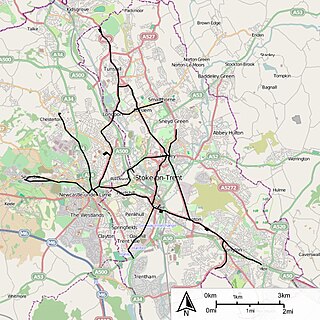
The Potteries Electric Traction Company operated a tramway service in The Potteries between 1899 and 1928.
Cold Meece railway station was a short-lived railway station built during the Second World War by the London, Midland and Scottish Railway (LMS) to serve ROF Swynnerton.
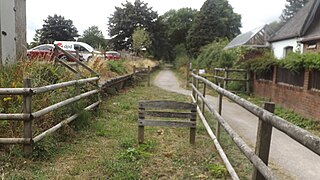
The Biddulph Valley line was a double tracked line that ran from Stoke-on-Trent to Brunswick Wharf in Congleton. The line was named after the town of the same name as it ran via the Staffordshire Moorlands and covered areas of East Staffordshire and Cheshire.
















